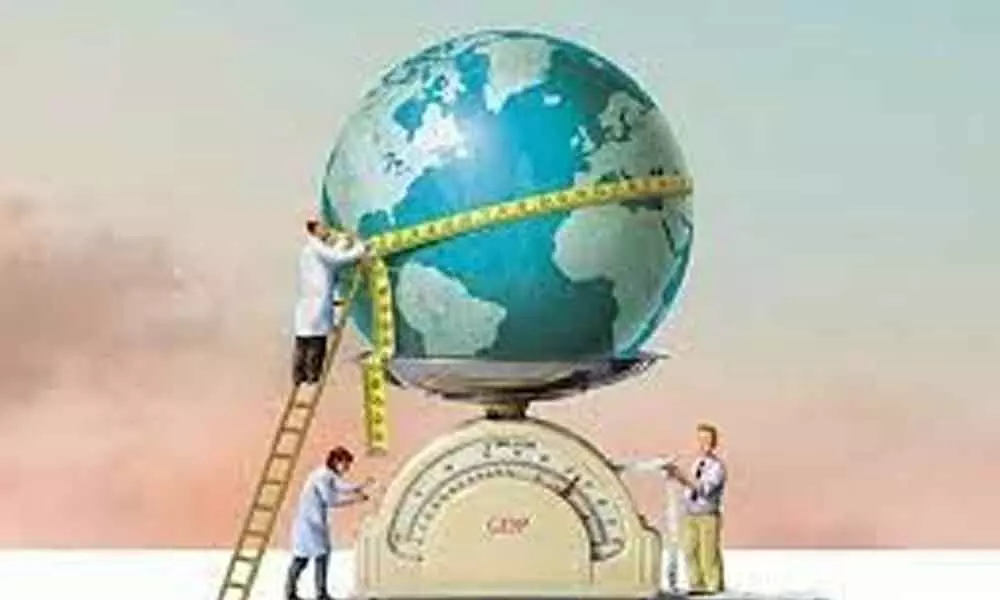Race for higher GDP destroying Earth

Representational Image
Several The inconvenient truth is before us. Despite all the global talks on climate change since the early 1990s, the latest report of the World Meteorological Organisation (WMO), the UN weather agency, has come as a dampener.
Several The inconvenient truth is before us. Despite all the global talks on climate change since the early 1990s, the latest report of the World Meteorological Organisation (WMO), the UN weather agency, has come as a dampener. Greenhouse gas emissions have hit a record high in 2020, not giving any indication of the world being able to meet the promise of keeping temperature rise below the target of 2.0 degrees expected to be achieved by the mid of the century.
"We are way off track," the WMO Secretary-General Petteri Taalas said, adding "we need to revisit our industrial, energy and transport systems and whole way of life." The United Nations Environment Programme (UNEP) meanwhile has warned that the world is on a track to see a temperature rise of 2.7 degrees by the end of this century if it is business as usual. This startling breaking-news comes a few days before the two-week deliberations of the 26th Conference of Parties to the UN Framework Convention on Climate Change (COP26) are scheduled to begin at Glasgow on Sunday, October 31. The climate negotiators are expected to not only grapple for the next two weeks, huddling together to sound alarm, setting national determined contributions (NDC), and wanting higher climate finance obligations to be legally enforced.
A day earlier, on October 30, leaders of G-20 countries will be meeting at Rome for a two day conclave, and again the focus, besides patting themselves for the Covid-19 response, is expected to revert to climate change. More so knowing the ambition their respected countries are expected to exhibit at the COP26, and the media built up looking for a more meaningful breakthrough than what has been achieved so far. With G-20 countries responsible for 80 per cent of the global emissions, their role and commitment on carbon neutrality or net-zero remains critical to keep the temperature rise in check. That is why Britain's Alok Sharma, the COP26 President, was forced to remark: "The response of G-20 will quite simply be make, or break."
Aptly titled 'People, Planet, and Prosperity' the G-20 leaders' Summit is happening at a time when the latest report of the Inter-governmental Panel on Climate Change (IPCC), while issuing a 'code red for humanity' warning, summed up the reasons for the climatic upheavals, by categorically stating: "It is unequivocal that human influence has warmed the atmosphere, oceans and land." Extreme weather conditions, including frequent cyclones, floods, drought and increasing human casualties highlights the extent of climate crisis. In 2020, WMO estimates climate disasters to have caused a loss of $238 billion in China, $87 billion in India and $85 billion for Japan. More recently, untimely heavy rains and resulting landslides and floods in the first fortnight of October have killed nearly 250 people in Uttarakhand, parts of Uttar Pradesh, Kerala in India, and in adjoining regions of Nepal.
Simply put, the climate catastrophe that the world is staring ahead is the outcome of the consumption-driven economic growth model that the world is following. Increasing economic growth requires higher use of energy, which leads to higher emissions. The higher the greenhouse gas emissions, the higher is the GDP. So the correlation that a higher GDP has with increasing climate shocks is clear. Radically reforming the economic growth design is something that is beyond the capacity of the climate negotiators, who can at best work out a timeline for climate finance to be delivered, and also set a target for emission-reduction trajectory.
Beyond this, it will be the role of international leadership to acknowledge that any meaningful outcome will come from decoupling growth from a devastating ecological footprint that economic growth leaves behind. After all, the way the global economic growth model has been cast, a high growth trajectory eventually results in resource depletion. For the political leaders, a higher GDP is the ultimate development indicator showcasing the performance of their government. The resulting environment havoc it leaves behind is a cost that people have to live with and silently suffer. The debate around climate change at least has been able to bring out the huge cost people pay by way of resulting destruction. To move away from the economic growth design, towards an economic system that does not lead to a climate catastrophe, calls for a transformative change in economic thinking, which will require the global leadership to demonstrate courage in guiding and leading the world towards a safe and healthy future.
In other words, the bull in the china shop – the race for a higher GDP - is already on a rampage. Unless tamed, it has the capacity to not only to further plunder whatever remains of the planet's natural resources, but to also heat it up to a point that will leave the planet literally burning. Aware of these hard realities, the G-20 leaders cannot go on seeking higher investments to boost production so as to achieve a higher GDP while at the same time call for stabilising global temperature rise. Even the highly anticipated climate finance delivery of $100 billion a year for the developing countries, beginning 2023, will not bring about any meaningful outcome unless the underlying intent is to drastically reduce the global material footprint.
For instance, we cannot go on clearing the Amazon forests on the one hand and at the same time call for technologies to help people mitigate climate change. We cannot go on pushing intensive farming systems across the globe and then at the same time talk of reducing emissions from agriculture. We cannot go on clearing large swaths of forests to accommodate the growing needs for mining and industry while making empty promises to conserve and protect the green lungs. At the same time we cannot go on redesigning economic policies that reduces savings and encourages people to spend more, thereby increasing consumption. Just a few illustrations, but I am sure readers will agree that all it requires is to reverse the economic thinking that has brought us to a tripping point.
That is why I have always maintained that an ever-lasting solution to the climate crisis lies in the hands of the G-20 leaders'. These leaders have to come out with their collective vision to save the planet, and demonstrate their willingness to take the bull by the horn. Getting over with their obsession with GDP is the first step. Measuring the social and environmental costs before taking up any economic activity, is the second. Invest more on human capital, and on conserving the nature at any cost. Not an easy task, I am aware but as Nelson Mandela had once said: "It always seems impossible until it's done."
(The author is a noted food policy analyst and an expert on issues related to the agriculture sector. He writes on food, agriculture and hunger)















